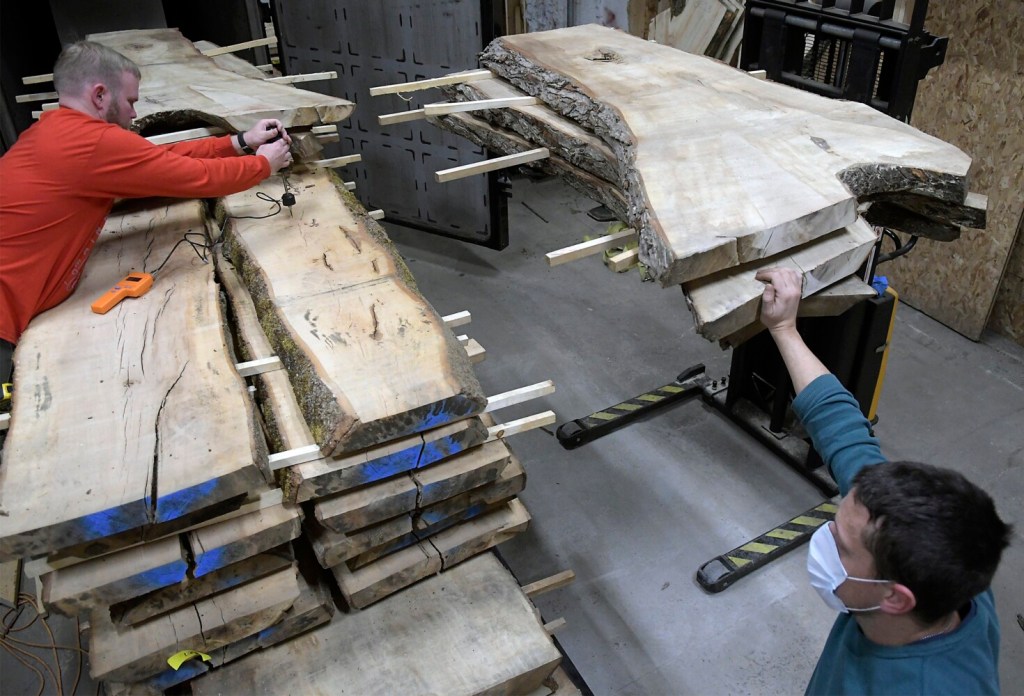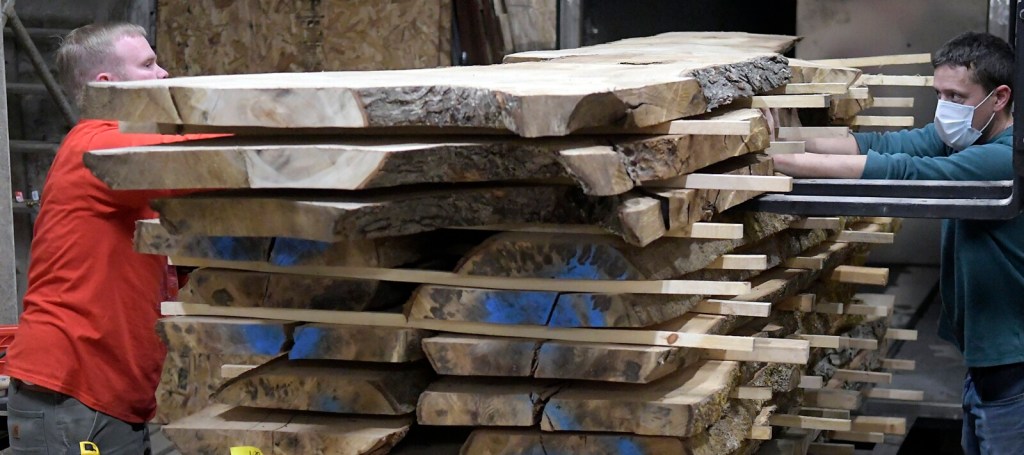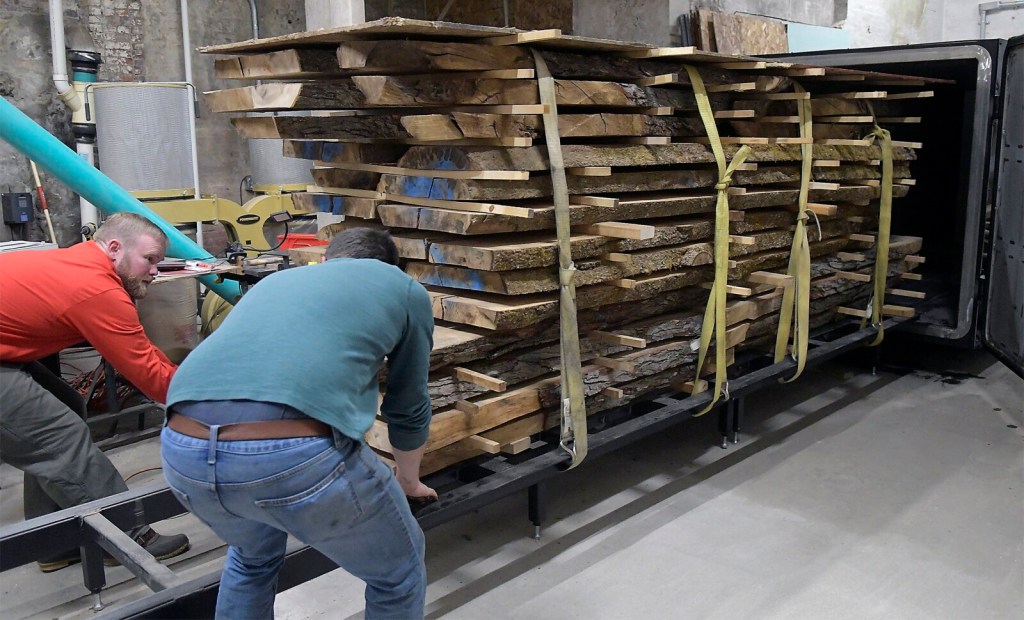WEST GARDINER — By day, Niles Krech and Steve Pracher are a criminal investigator and pharmacist, respectively. By night, they are the only people in Maine who produce urban live slab lumber.
The idea to start Maine Urban Timber Co. came after the pair built a sawmill for fun.

When they realized the size and the scope of the sawmill that they had made, Krech did some research and found urban live slab lumber was missing — and might have a market — in Maine.
“I looked into different resources and saw that there were people that were specializing in producing urban live slab lumber,” Krech said. “It’s a market that Maine is missing, even in New England.”
Urban live slab lumber utilizes a different method than what is normally used to produce wooden slabs.
After a tree is cut, the normal method is to air dry the slabs. However, Maine Urban Timber Co.’s methods involve a vacuum kiln to remove moisture from the wood, reducing the drying process from about a year to a couple of weeks.
With his background in woodworking, Krech said there are many people in Maine who produce wood slabs, but not anyone who produces and dries urban lumber.
Contractors or those who plan to use the slabs for their own projects or woodworking are among the company’s customers.
Krech said the company’s wooden slabs run from about $7 to $160. Samples are displayed on the company’s website — www.maineurbantimberco.com.
“Very recently, live edge slab lumber has become popular,” Krech said. “It’s bigger out West, and there are large cities in the West that are producing it. I kept digging and realizing that it’s a thing, and growing throughout the nation and picking up speed.”

Niles Krech, left, and Stephen Pracher separate stacks of urban live slab lumber Monday at the Maine Urban Timber Co. in West Gardiner. Some of the pieces measure more than 6 feet long and 40 inches wide. Andy Molloy/Kennebec Journal
The “urban” reference in urban live slab lumber implies the trees are from urban settings. Many of the trees Maine Urban Timber Co. uses are from Portland or surrounding communities.
The city of Portland maps trees throughout the city — as many as 20,000 — that might be available for removal.
Jan Santerre of the Maine Forest Service said urban trees can grow large because of the environment.
“Trees that grow in open conditions with full access to sunlight tend to grow in a more rounded form, rather than straight up towards the light,” she said. “This can lead to larger main stems.
“Many urban trees, if successful, can also grow to great age and size, which leads to unique character in slabs if those trees have to be removed for safety of nearby homes, sidewalks, playgrounds, etc.”
Because Krech and Pracher are not arborists, they cannot cut the trees. Instead, they rely on professionals to inform them of trees being brought down.
“(The arborists) will tell us that they have a 5,000-pound red oak that they have to do something with,” Krech said, adding trees are likely to be turned into firewood if not repurposed by Maine Urban Timber Co.
After a tree is cut, Krech and Pracher transport it to their shop, cut the tree at their sawmill, air dry the wood and then place it into their kiln.

Niles Krech, left, and Stephen Pracher pull slabs of urban live slab lumber Monday from the vacuum kiln at the Maine Urban Timber Co. in West Gardiner. Some of the pieces measure more than 6 feet long and 40 inches wide. Andy Molloy/Kennebec Journal
Krech and Pracher bought the kiln in Vermont and run one of two businesses in Maine that own a 13-foot long and 5-foot wide machine.
“It runs for 24 hours a day,” Krech said. “Once a week, we open it up and check on the wood. We push the wood in and turn it over, and the kiln dries it nice and slow. It pressurizes the entire chamber and allows the wood to stay flat.”
Wood is removed Monday nights, after three to four weeks inside the kiln.
Santerre said one of the reasons urban slab lumber has grown popular is the appeal of creating furniture from wood that has history — a story — and a unique look.
She recalled the time the town of Yarmouth took down “Herbie” the elm tree after it died from disease.
“People who knew the tree wanted to have a piece made from it,” she said, “and others that fell in love with the story of the tree and its caretaker wanted to take home a piece of the story.”
Krech said such is often the case with urban slab lumber. Many customers like knowing where a tree is from and the history it might possess.
They also value the important roles trees hold in the environment.
“Their shade helps to save energy, while also slowing driving rains and absorbing pollutants,” Santerre said. “Trees provide homes for wildlife, all while mitigating human impacts by absorbing carbon and turning it into wood.
“By turning those usable trees into items that will last a lifetime, we extend their carbon cycle just a little bit longer.”
Send questions/comments to the editors.






Success. Please wait for the page to reload. If the page does not reload within 5 seconds, please refresh the page.
Enter your email and password to access comments.
Hi, to comment on stories you must . This profile is in addition to your subscription and website login.
Already have a commenting profile? .
Invalid username/password.
Please check your email to confirm and complete your registration.
Only subscribers are eligible to post comments. Please subscribe or login first for digital access. Here’s why.
Use the form below to reset your password. When you've submitted your account email, we will send an email with a reset code.